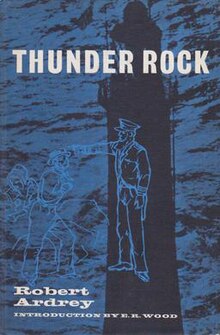Thunder Rock (play)
| Thunder Rock | |
|---|---|
 |
|
| Written by | Robert Ardrey |
| Characters | Charleston, Streeter, Nonny, Inspector Flanning, Captain Joshua, Briggs, Dr. Stephan Kurtz, Melanie, Anne Marie, Miss Kirby, Chang |
| Date premiered | November 14, 1939 |
| Place premiered | Mansfield Theatre |
| Original language | English |
| Subject | World War II, American Isolationism |
| Genre | Drama |
| Setting | Thunder Rock Lighthouse, Lake Michigan |
Thunder Rock is a 1939 play by Robert Ardrey.
The initial Broadway production, put on by the Group Theater and directed by Elia Kazan, closed after a short run, but the play was far more successful in wartime London. Thunder Rock became a symbol of British resistance and was the most notable play of World War II. It was first produced in a little-known theater in South Kensington but was transferred, with secret funding from Her Majesty's Treasury, to the Globe Theatre in London's West End.
Thunder Rock has seen many adaptions, including a BBC radio version in 1940 and a 1942 film starring Michael Redgrave and James Mason. In 1947 CBS broadcast a radio production; it was awarded a Peabody Award. Stage productions have been mounted all over the world, including an unauthorized production in Zurich, a U.S. government-sponsored production in occupied Berlin, and popular post-war productions throughout Europe and Africa, including in Harare and Nairobi.
The Dramatists Play Service gives the following synopsis of Thunder Rock:
The action passes in a lighthouse on Lake Michigan. Charleston, the keeper, has taken a job there to flee from a detestable world. Opposing Charleston's pessimism, Streeter, his friend, says he is giving up his job to become an active member of society again. Streeter believes our world can be brought out of its chaos if people do something about it. Filled with this determination, he leaves to become an aviator. Charleston retreats further into a fantastic world of his own building. The people of this world are half a dozen of the sixty who were shipwrecked ninety years ago. Believing that "Mankind's got one future—in the past," Charleston breathes life into these creatures of his imagination. They live again on the stage. As he talks to them we see passengers as they really were, each seeking sanctuary from a disturbed Europe, running away from life, yet needing the same hope and strength as Charleston himself. Charleston's sincerity convinces these creatures that he really has the courage to lead his fellow men into a better world, and in this faith they are content to die again. Inspired by their confidence, the lighthouse-keeper returns to useful work, determined to create a new order out of the chaos of the old.
...
Wikipedia
